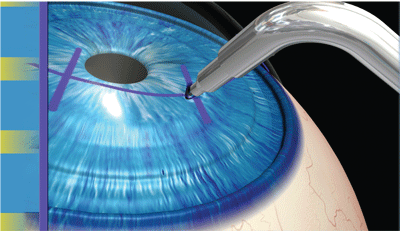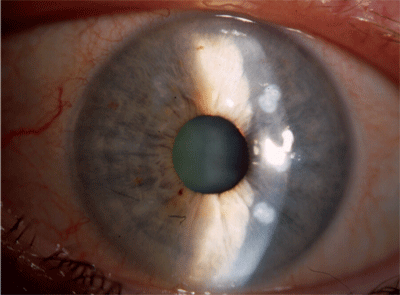Presbyopia is probably one of the most difficult topics to discuss with patients. This is partly due to vanity. Someone who has never needed glasses now cannot read without them, a sure sign of advancing age. Also, patients may not fully understand what is happening to their eyesespecially if they are nearsighted and accustomed to removing their glasses to read. Lens Exchange
The good news, however, is that a myriad of options are now available to presbyopic patients, including refractive surgery. This article will discuss one of the most recent options available to these patients: NearVision Conductive Keratoplasty (CK).
This procedure has been successful for many of the presbyopes in our practice. Typical visual acuity outcomes are 20/30 to 20/50 for distance and 20/20 for near vision in the surgically corrected eye.
Patient Education
In our practice, we remind patients that vision correction is a continuum: It changes as they age. We educate them about how the eye and vision evolve over time and about the best methods to correct for refractive errors along the way. We also make sure to tell patients about all the options currently available. Besides glasses and contact lenses, we talk about LASIK and PRK to younger patients, NearVision CK to presbyopes and multifocal IOLs for cataract patients. (See The Continuum of Refractive Care, below.)
The Continuum of Refractive Care
Procedure
Age
Refraction
LASIK
18 to 55
-8.00D to +5.00D
NearVision CK
45 to 60
-0.75D to +1.00D
55-plus
-16.00D to +8.00D
A large group of patientsabout 50,000 every dayis becoming moderately presbyopic.1 As their eyesight deteriorates further, they may end up in your exam room.
Many of these patients are emmetropes who have never experienced vision difficulties before. However, we know from the Beaver Dam Eye Study that younger patients become more hyperopic as they age, while older patients become more myopic.2 The study showed that the 10-year change in refraction among 2,937 patients was +0.48D for persons ages 43 to 59, +0.03 for those ages 60 to 69 and -0.19D for those ages 70-plus.
So, a typical candidate for NearVision CK patient who presents to your practice may be in his or her early to mid 40s and have +0.50D or +0.25D of presbyopia. Although patients such as this may not yet consider themselves candidates for surgery, they make ideal NearVision CK patients. (See The Ideal Candidate for NearVision CK, below.)
The Ideal Candidate For NearVision CK
40 to 58 years of age
-0.75D to +1.00 D of refractive error
Risk-averse
Tired of reading glasses
Our goal of NearVision CK is to allow patients to be free of eyeglasses 90% of the time or more. They may experience occasional night blur that requires extra correction and/or other minor problems, but if this amounts to 10% of their day or less, the procedure is considered successful.
Additionally, patients should know that:
Some discomfort will follow the procedure. This is easily managed with non-steroidal anti-inflammatory drugs (NSAIDs).
Vision will not be optimal immediately after the procedure. In all hyperopic refractive surgeries, the surgeon overcorrects slightly to compensate for the slight regression that occurs three to four months post-op.
Presbyopia will continue to progress. Within two to four years, re-treatment will be necessary. The presbyopia will eventually progress to a point at which NearVision CK will not be effective. Another procedure, such as a clear lens extraction with a multifocal IOL implant, might then be recommended.
The Procedure
The FDA first approved conductive keratoplasty in April 2002 for the treatment of hyperopia in patients over age 40. In March 2004, the FDA approved Refractecs Viewpoint CK system for performing NearVision CK on presbyopic patients.
In NearVision CK, the surgeon creates accommodation by increasing the overall curvature of the cornea. He or she does this by applying radio frequency energy in a circular pattern around the outer cornea. The energy causes the collagen in the cornea to shrink, creating a restrictive band to produce an increase in the corneas curvature.

In NearVision CK, the surgeon applies a thin probe to release radio frequency energy in a circular pattern around the outer cornea. The energy causes the collagen in the cornea to shrink, producing an increase in corneal curvature.
The change in corneal shape is accomplished by applying a hair-thin probe to the surface of the cornea; this releases the radiofrequency energy. The surgeon creates a ring of eight to 32 application spots around the periphery of the cornea. Striae form between the spots in the corneal tissue, creating a purse string effect that reshapes and steepens the cornea of the non-dominant eye to induce -1.00D to -1.50D of myopia.
When CK was first introduced, the surgeon would insert the probe deep in the stroma to create the application spots. Ophthalmologist H.L. Rick Milne III, of Columbia, S.C., began performing CK in 2002 and found that he could apply minimal pressure to the corneal surface and still retain the clinical outcome. The company now refers to this development as LightTouch technology. Induced astigmatism is a potential side effect of NearVision CK,4 but the LightTouch technology can reduce the occurrence.
In clinical trial data submitted to the FDA, 98% of patients treated with CK had vision of J5 at one year post-op, while 87% had J3 or 20/20 vision binocularly. There were no reported serious, sight-threatening or unanticipated safety events.
In another clinical study, 77% of the eyes treated for near had an uncorrected visual acuity (UCVA) of J3 or better at six-months post-op, and 85% of all patients had a binocular uncorrected distance visual acuity of 20/25 or better along with J3 or better at near.5 Also, 66% of eyes treated for near had a manifest refractive spherical equivalent (MRSE) within 0.50 D of the intended correction at six months. In another study, 12 months after CK, the mean near UCVA was J1 (range: J3 to J1) with 90% of eyes J1 and 100% of eyes J3 or better.4
Surgeons also have successfully used CK in post-LASIK and PRK patients; however, CK is contraindicated following radial keratotomy since the cornea is too unpredictable. In clinical study data presented at the American Academy of Ophthalmologys annual meeting last month, Refractec reported that in a cohort of 60 post-LASIK patients ages 41 to 63 who underwent NearVision CK, 95% of patients achieved near visual acuity of J3, 83% of patients achieved 20/32 or better intermediate vision, and 90% of patients reported satisfaction with quality of vision and depth perception.
 |
|
A patient at one month after undergoing NearVision CK. The probe does not contact the central cornea, and the only scarring that occurs is where the probe is applied. Visible scarring decreases over time. |
Patient Selection
Most patients with whom I discuss NearVision CK have never heard of it, but are intrigued nonetheless. To help determine if they will be happy with the results, I typically do a contact lens trial for monovision but with a difference from traditional monovision: I use a multifocal contact in the non-dominant eye. This type of trial provides the truest representation of CK-treated vision. Previously, I used normal monovision contact lenses, but they produced more vision change than these patients could toleratein the realm of 20/60 or 20/70 distance vision. With the multifocal contact lens, I can keep distance visual acuity in the 20/30 range, which is more in line with a NearVision CK outcome.
I use a multifocal lens with a correction that is +0.50D to +0.75D over the patients distance refraction and with a low add. In the dominant eye, I simply correct for distance, if necessary. This process works extremely well, and I now refer about two patients a week to one of our refractive surgeons for a full consultation.
After patients have met with the surgeon, about 80% go on to have NearVision CK.
CK Facts
One of the main advantages of NearVision CK is its safety profile. The probe does not contact the central cornea, and the only scarring that occurs is where the probe is applied. The scars are visible, but they decrease over time.
As stated earlier, some regression occurs with CK; however, clinical studies show its similarities to that seen in hyperopic patients who undergo LASIK or PRK. In one two-year study, for example, researchers observed mild hyperopic regression, but the rate of regression was low and decreased over a two-year follow-up period.6
We tell patients they will become more presbyopic over time, and two to four years down the road, they may need an enhancement. Overall, however, our experience shows that the refractive results are very stable.
In our practice, we see presbyopes as one of the most important patient populations. Besides refractive surgery options, our surgeons are involved in multiple clinical studies of multifocal IOLs. As this technology advances, I suspect these IOLs will eventually become the procedure of choice for older refractive surgery patients when they require cataract surgery.
As optometrists, it is important for all of us to recognize that presbyopia is going to be the next big thing in refractive surgery. Either we can accept it and ensure that our patients know all their options and receive the best possible care, or we can watch them walk out the door and down the street.
Dr. Geffen specializes in family eye care, contact lenses, low vision and refractive surgery consultation at Gordon Binder & Weiss Vision Institute, a group practice in La Jolla, Calif.
1. Rakow PL. Presbyopic correction with contact lenses. Ophthalmol Clin North Am. 2003 Sep;16(3):365-81.
2. Lee KE, Klein BE, Klein R, Wong TY. Changes in refraction over 10 years in an adult population: the Beaver Dam Eye study. Invest Ophthalmol Vis Sci 2002 Aug;43(8):2566-71.
3. Conductive Keratoplasty (CK)-Monovision for Presbyopia gets FDA approval. The Eye Digest. Available at: www.agingeye.net/mainnews/ck.php. (Accessed December 1, 2006).
4. Stahl JE. Conductive keratoplasty for presbyopia: 1-year results. J Refract Surg 2006 Feb;22(2):137-44.
5. McDonald MB, Durrie D, Asbell P, et al. Treatment of presbyopia with conductive keratoplasty: six-month results of the 1-year United States FDA clinical trial. Cornea 2004 Oct;23(7):661-8.
6. Lin DY, Manche EE. Two-year results of conductive keratoplasty for the correction of low to moderate hyperopia. J Cataract Refract Surg 2003 Dec;29(12):2339-50.

